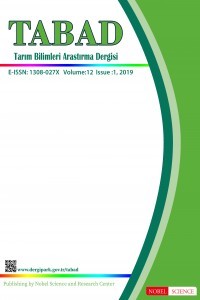The Importance of Mapping Natural and Cultural Routes in Rural Tourism: Bartın Case
Route planning, Network route design, Western Black Sea, Bartın
___
- Budowski, G., 1976. Tourism and Environmental Conservation: Conflict, Coexistence or Symbiosis. Environmental Conservation 3: 27–31.
- Higginbottom K.,Tribe A., Booth R., 2003. Contributions of Non-consumptive Wildlife Tourism to Conservation Nature-based Tourism, Environment and Land Management. Edited by R. Buckley, C. Pickering and D.B. Weaver. CABI Publishing, UK.
- Durusoy, E. 2013. From An Ancient Road to A Cultural Route: Conservatıon And Management Of The Road Between Milas And Labraunda /Tarihi Yoldan Kültürel Rotaya: Milas ve Labraunda Arasındaki Yolun Korunması Ve Yönetimi ODTÜ, Fen Bilimleri Enstitüsü, Mimarlık Bölümü, Restorasyon Anabilim Dalı Yüksek Lisans Tezi.
- Karataş, E., 2011. “The Role of Cultural Route Planning in Cultural Heritage Conservation: The Case of Central Lycia.” ODTÜ, Fen Bilimleri Enstitüsü, Mimarlık Bölümü, Restorasyon Anabilim Dalı Yüksek Lisans Tezi.
- EICR, 2017. Mission. European Institute of Cultural Routes.http://culture-routes.net/the-institute/mission. Accessed on 22.06.2017.
- CRS, 2017. Culture Routes in Turkey-Long Distance Hiking Trails for All. Culture Route Society can be reached from http://cultureroutesinturkey.com. Accessed on 01.04.2013
- UNESCO, 2017. Further information about the “World Heritage Convention for the Protection of the World Cultural and Natural Heritage of UNESCO” can be obtained from: http://whc.unesco.org/archive/convention-en.pdf. Accessed on 21.06. 2017.
- AICOMOS, 2017. 2001 Making Tracks Making Tracks. From Point to Pathway: the Heritage of Routes&Journeys. http://www.aicomos.com/2001-makingtracks/, Accessed on 22.06.2017.
- Görmüş, S., Atmiş, E., Özkazanç, N.K., Günşen, H.B., Artar, M. 2016. Ekorota Bartın: Doğal ve Kültürel Koridorların Haritalanması. Bartın Üniversitesi Yayınları No: 26, Orman Fakültesi Yayınları No: 11. Stil Matbaacılık, İstanbul.
- TÜİK, 2015. Republic of Turkey Turkish Statistical Institute Address Based Population Registration System Results. http://tuikapp.tuik.gov.tr/adnksdagitapp/adnks Accessed on 11.11.2015.
- GDF, 2015. Republic of Turkey General Directorate of Forestry, Official Forestry Statistic 2014, Ankara, TURKEY.
- TÜİK, 2013. Population and Housing Census 2011. Republic of Turkey Turkish Statistical Institute, Ankara, TURKEY, p. 304.
- ÇEKÜL, 2015. Kültür Rotaları Planlama Rehberi. Tarihi Kentler Birliği Kılavuz Kitapçıklar Dizisi 3. İstanbul.
- UNWTO, 2015. World Tourism Organization Global Report on Cultural Routes and Itineraries, Affiliate Members Report: vol.12, s. 38.
- Turoğlu, H. and Özdemir, H., 2005. Determination of Ecotourism Potential in Bartın City. Eastern Geographical Review, 10(13): 97-116.
- Başlangıç: 2008
- Yayıncı: Nobel Bilim ve Araştırma Merkezi Limited
The Importance of Mapping Natural and Cultural Routes in Rural Tourism: Bartın Case
Sevgi GÖRMÜŞ, Erdoğan ATMIŞ, Hikmet Batuhan GÜNŞEN, Nuri Kaan ÖZKAZANÇ, Mustafa ARTAR
Bringing Lavander to Economy in Rural Development and Rural Tourism Scope
Ziynet YIGIT, A. Omer AKMAN, Merve ALKAN, İhsan OCAL, Aysun CELIK
Gastronomi Turizminde Bitkisel Çayların Yeri: Beypazarı Örneği
Ekolojik Turizm Kavramı: Fethiye Örneği
In Vitro Haploidy Techniques in Ornamental Plants
Mehmet TÜTÜNCÜ, Tolga İZGÜ, Başar SEVİNDİK, Yesim YALCIN MENDİ
